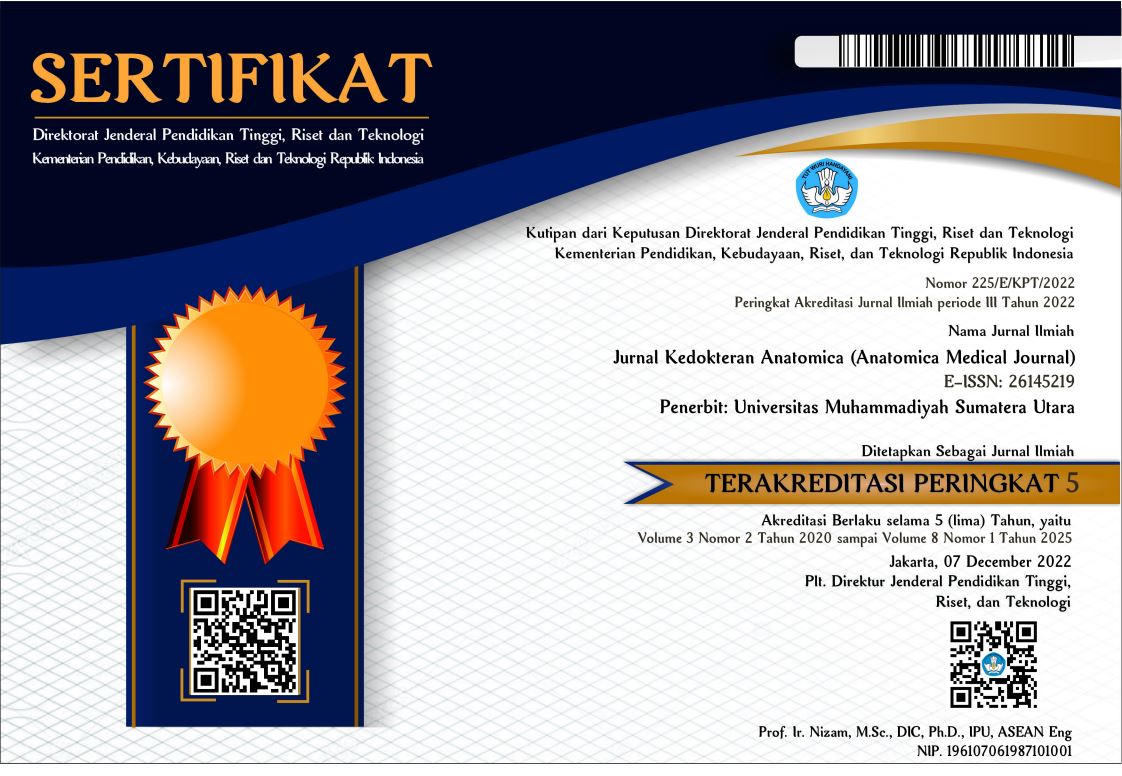Perbandingan Efektivitas Infusa Daun Jambu Biji Merah (Psidium Guajaval) Dengan Temephos Terhadap Kematian Larva Nyamuk Aedes Aegypti
Abstract
Conclusion: Red guava leaf infusa infected infected was use with a concentration of 1.05% as the most effective concentration killed the larvae with 96.0% mortality percentage, but in general the concentration of red guava leaf infected concentration of 1.05% still can not kill the Aedes mosquito larvae 100% aegypti such as temephos.
Full Text:
PDFReferences
World Health Organization. Dengue: guidelines for diagnosis, treatment, prevention and control; 2009; 4-5.
Pusat Data dan Surveilans Epidemiologi Kementrian Kesehatan RI. Buletin jendela epidemiologi; 2010; 1.
Sukana B. Pemberantasan vector DBD di Indonesia; 3 (1): 9
Nugroho AD. Perbedaan jumlah kematian larva aedes aegypti setelah pemberian abate dibandingkan dengan pemberian serbuk serai (andropogon nardus). Jurusan Ilmu Kesehatan Masyarakat Fakultas Ilmu Keolahragaan Universitas Negeri Semarang; 2013 .
Ridha MR, Khairatun N. Larva aedes aegypti sudah toleran terhadap temepos di kota banjarbaru, kalimantan selatan. 2011; 3 (2): 96.
Pinem SE, Irnawati M, Evi N. Efektivitas ekstrak daun jambu biji (psidium guajava l.) Sebagai larvasida nyamuk aedes spp. pada ovitrap. Fakultas Kesehatan Masyarakat Universitas Sumatera Utara; 2015.
Fuadzy H, Hendri J. Indeks entomologi kerentanan larva Aedes aegypti terhadap temefos di Kelurahan Karsamenak Kecamatan Kawalu Kota Tasikmalaya. 2015; 7 (2): 64
Badan POM RI. Acuan sediaan herbal. Jakarta: Badan Pengawas Obat dan Makanan Republik Indonesia; 2007; 5.
Pedro M, Gutierrez, Aubrey NA, Bryle AL, Eugino, Santos MF. Larvacidal activity of selected plant extract against the dengue vector Aedes aegypti mosquito. Int. res. J. biological sc., 2014; 3 (4): 23-32.
Wardani RS, Mifbakhuddin K, Yokorinanti. Pengaruh konsentrasi ekstrak daun tembelekan (Lantana camara) terhadap kematian larva Aedesa egypti. Jurnal kesehatan masyarakat Indonesia. 2010; 6 (2): 30-38.
Cania E, Setyaningrum E. Uji efektivitas larvasida ekstrak daun legundi (Vitestrfolia) terhadap larva Aedes aegypti. Medical journal of lampung university. 2013; 2 (4): 53-60.
Koneri R, Hesky HP. Ujie kstrak biji mahoni (Swietenia macrophylla) terhadap larva Aedesa egypti vector penyakit demam berdarah. Jurnal MKMI. 2016; 12 (4): 220-221.
Aradilla AS. Uji efektivitas larvasida ekstrak ethanol daun mimba (Azadirachta indica) terhadap larva Aedes aegypti. Fakultas Kedokteran Universitas Diponegoro Semarang: 2009
DOI: https://doi.org/10.30596/anatomica
DOI (PDF): https://doi.org/10.30596/amj.v3i1.3565.g3730
Refbacks
- There are currently no refbacks.
Jurnal Kedokteran Anatomica/ Anatomica Medical Journal (AMJ)
E-mail: amj_fk@umsu.ac.id || Editorial Contact: 081375150018
This work is licensed under aCreative Commons Attribution-ShareAlike 4.0 International License.


.png)
